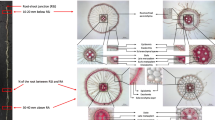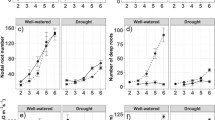Abstract
Understanding the growth and physiological responses of rice to upland conditions would be helpful for designing treatments to improve the tolerance of rice under a rainfed system. The objective of this study was to investigate the initiation, elongation and membrane stability of seminal, lateral and adventitious roots of upland rice after 9-d upland condition treatment. Compared with control roots under waterlogged conditions, upland water deficiency conditions favor seminal and lateral root growth over adventitious root growth by accelerating seminal root elongation, promoting lateral root initiation and elongation, and reducing the elongation and number of adventitious roots. Enhanced total root number and length resulted in increase of total root dry weight and thereby increasing the root-to-shoot ratio. Organic compound leakage from seminal root tips and adventitious roots increased progressively to some extent with upland culture duration, while significant increases in semial root tips were the consequence of loss of membrane integrity caused by the upland-condition enhanced growth.
Similar content being viewed by others
References
Huang, B., Johnson, J. W., Box, J. E. and NeSmith, D. S., 1997. Root characteristics and hormone activity of wheat in response to hypoxia and ethylene.Crop Sci.,37: 812–818.
Huang, B. and Gao, H., 2000. Root physiological characteristics associated with drought resistance in tall fescue cultivars.Crop Sci.,40: 196–203.
Mergemann, H. and Sauter, M., 2000. Ethylene induces epidermal cell death at the site of adventious root emergence in rice.Plant Physiol,124: 609–614.
Miyamoto, N., Steudle, E., Hirasawa, T. and Lafitte, R., 2001. Hydraulic conductivity of rice roots.J. Exp. Bot,52: 1835–1846.
Price, A. H. and Tomos, A. D., 1997. Genetic dissection of root growth in rice II: mapping quantitative trait loci using molecular markers.Theor. Appl. Genet.,95: 143–152.
Yamamoto, Y., Kobayashi, Y. and Matsumoto, H., 2001. Lipid peroxidation is an early symptom triggered by aluminum, but not the primary cause of elongation inhibition in pea roots.Plant Physiol.,125: 199–208.
Yamauchi, A., Pardales, J. R. and Kono, Y., 1996. Root System Structure and Its Relation to Stress Tolerance.In: Ito, O., Johansen, C., Adu-Gyamfi, J. J.,et al. eds, Dynamics of roots and nitrogen in cropping systems of the semi-arid tropics, p. 211–233.
Zhang, W. P., Shen, X. Y., Wu, P., Hu, B. and Liao, C. Y., 2001. QTLs and epistasis for seminal root length under a different water supply in rice.Theor. Appl. Genet,103: 118–123.
Author information
Authors and Affiliations
Additional information
Project (No. G1999011700) supported by National Key Basic Research Special (863) Foundation of China
Rights and permissions
About this article
Cite this article
Yang, L., Zheng, Bs., Mao, Cz. et al. Seminal, adventitious and lateral root growth and physiological responses in rice to upland conditions. J. Zhejiang Univ. Sci. A 4, 469–473 (2003). https://doi.org/10.1631/jzus.2003.0469
Received:
Accepted:
Published:
Issue Date:
DOI: https://doi.org/10.1631/jzus.2003.0469




